
John Deere X9 1000 Combine
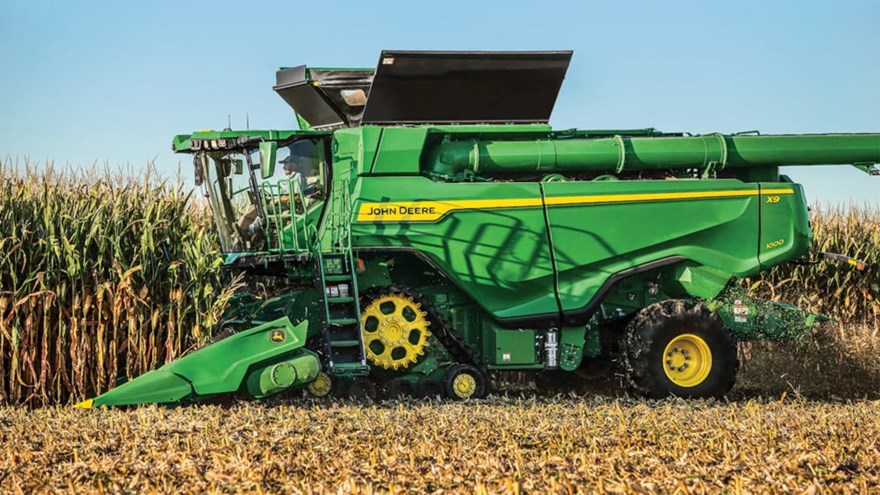
X9 1000
- 630 Max engine horsepower
- 4.6 bu/s (162.1 liters/s) peak unload rate
- 420-bushel (14,800-liter) power folding grain tank
- Integrated G5Plus CommandCenter™ Display and StarFire™ Receiver with available SF-RTK
- Get a Quote Payment Calculator
- View Product Brochure
- View Front End Equipment Brochure
- ShopJohn Deere
Get A Quote
Fields with asterisks* are required. Please email our helpful staff with any questions or comments using the contact form.
Loan Calculator
Use the Loan Calculator to help you determine the financing and payment options that are best for you.
**The accuracy of this calculator and its applicability to your circumstances is not guaranteed. You should obtain personal advice from qualified professionals. This information is provided for illustrative purposes only and does not constitute an application. This notice does not guarantee loan approval, nor is it an offer or commitment to make a loan to you on the above terms.
Features
Get more during your rice harvest with the X9 rice package
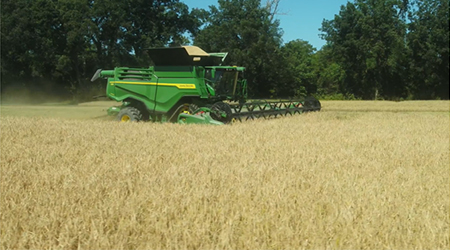 X9 1000 harvesting in rice
X9 1000 harvesting in rice
Overview
The X9 combine has been optimized to handle the extreme wear conditions a rice harvest can bring about. By utilizing the most advanced coatings and wear resistant materials, the X9 combine is built to last longer and do more.
Benefits
- Lower cost of ownership
- Extended wear life in extreme conditions
- Lower potential down time
- Up to 65 percent more capacity than an S790 combine
- Harvest up to 3,200 bushels/hour
Additional details
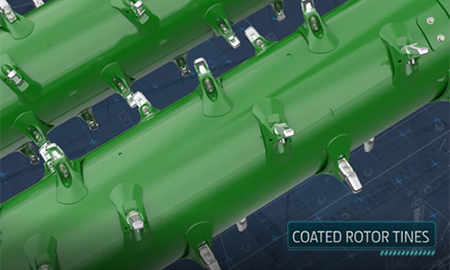 Coated rotor tines
Coated rotor tines
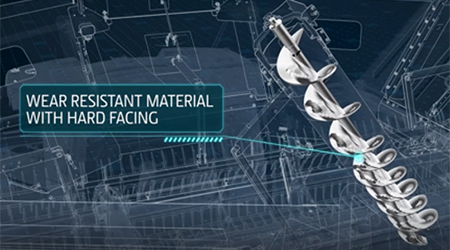 Wear resistant material with hard facing
Wear resistant material with hard facing
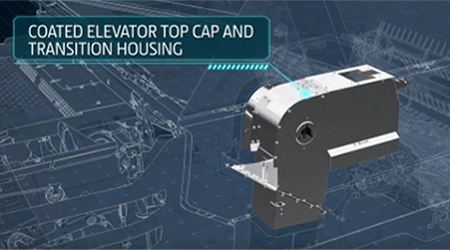 Coated elevator top and cap and transition housing
Coated elevator top and cap and transition housing
- Only available in X9 1000
- Requires the combination of the following order codes
- Code 4324 - Extreme Wear Large Wire Concaves or Code 4365 - Extended Wear Round Bar Concaves
- Code 5231 - Extreme Wear Grain Handling System
- Code 4890 - X Series Dual Separator (XDS) Extreme Wear
- Code 5437 - 28.5 ft (8.7M) Power Folding Unloading Auger
- Code 575B - Deluxe - Fine Cut - PowerCast™ - Rice Version
- Feederhouse
- Stainless steel feederhouse floor
- Deflector shield to protect solenoid connections on feederhouse life cylinders
- Protective sheathings on exposed hydraulic hoses
- Feed accelerator
- Coated chevron nose
- Stainless steel feed ramp plate
- Coated hardware
- Dual separator
- Hard faced rotor feed flights
- Stainless steel rail liners
- Z-bars made from special wear resistant material
- Coated rotor tines
- Special coated and designed rice elements
- Stainless steel top covers
- Extra coated rice threshing elements
- Stainless steel discharge grate floor
- Grain handling
- Wear resistant tailings auger
- Hardfaced flighting clean grain auger
- Coated elevator boat
- Coated elevator top cap and transition housing
- Wear resistant material with hard facing on the loading auger
- Stronger gears on loading auger gear box
- Wear resistant grain tank cross augers
- Wear resistant material in auger trough
- Hard facing on first and last auger flightings in unload auger
- Residue management
- Stainless steel floors
- Wear resistant chopper knives and bushings
Lower your harvesting costs, raise your expectations
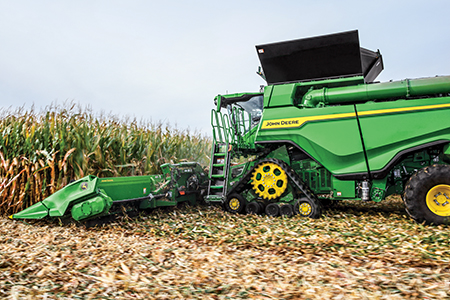 X Series harvesting high-moisture corn
X Series harvesting high-moisture corn
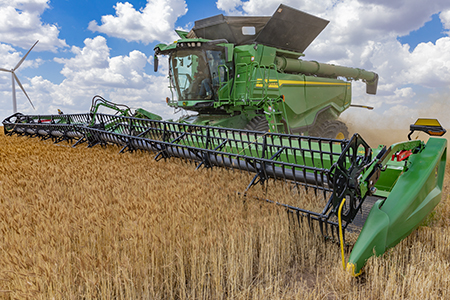 X Series harvesting wheat
X Series harvesting wheat
The X Series helps reduce fuel costs by 20 percent per bushel harvested. Plus, you can count on an improved grain tank sample and better residue spread, which adds up over a harvest season. With this improved design, you can harvest more acres per day with improved fuel consumption.
- 20 percent better fuel efficiency per bushel harvested - Run 14 hours without stopping for fuel and enjoy fuel savings of up to 20 percent or more as measured in gallons per bushel. An updated John Deere engine, belt drive system, and ProDrive™ XL transmission make it possible. The JD14 (13.6 L, 830-cu in.) engine runs at 1900 rpm during harvest and is partnered with an updated driveline layout that reduces parasitic loss to improve fuel economy. The ProDrive XL transmission leverages two efficient motors to improve power transfer at typical harvesting speeds, and when moving to the next field you can travel up to 40 km/h (25 mph) to get back to harvesting.
- 36 percent larger cleaning shoe more efficiently cleans high-yielding and high-foreign-matter crops with less loss and a better grain tank sample - Conditions may change throughout the day but your grain quality won’t. The massive 7-m2 (75-sq ft) Dyna-Flo™ XL cleaning shoe delivers 36 percent more cleaning area to effectively handle thin dry crop, thick wet crop, and everything in between.
- Uniform residue spread up to 15.2 m (50 ft) with the ability to properly size residue from the cab - Size the chaff and spread it where you want it to speed decomposition and improve soil warming – a feature you’ll really appreciate next year in the spring.
More bushels per hour, more acres per day
 X Series harvesting corn, wheat, and canola
X Series harvesting corn, wheat, and canola
If you ever wished you could harvest a few more acres per day, the X Series Combines is the right choice for you. More capacity – up to a 70 percent increase on the X9 1100 – means you can cover a lot more ground with improved grain quality and less grain loss.
| Crop type | S790 | X9 1000 | X9 1100 |
| Harvesting capacity (percent above an S790) |
|||
| Tough wheat | 100 percent | 134 percent | 170 percent |
| Canola | 100 percent | 135 percent | 140 percent |
| High-moisture corn | 100 percent | 130 percent | 150 percent |
| Soybeans | 100 percent | 130 percent | 145 percent |
- Harvest up to 7200 bu per hour in high-yielding corn and 30 acres per hour in wheat – The X Series dual separator with 45 percent more threshing area and 80 percent more separating area than previous models improve performance in the toughest conditions.
- Reduce losses and improve grain tank quality – With 36 percent more cleaning area and 85 percent more air flow than previous models, the Dyna-Flo™ XL cleaning shoe was built to handle the increased capacity from the rotors. The industry’s largest cleaning shoe keeps loss levels low and grain quality high; you’ll really appreciate the difference in tough wheat, canola, and high-moisture corn.
John Deere X9 1100 vs. CLAAS® 8800 – Independent PAMI benchmarking
 X9 1100, PAMI storage band and collector
X9 1100, PAMI storage band and collector
Combine capacity, time, and money - what are they worth to you? In late September and early October of 2020, John Deere contracted PAMI (Prairie Agricultural Machinery Institute) to conduct independent benchmarking of the John Deere X9 1100 Combine versus the CLAAS 8800 Combine. PAMI tested these combines in tough wheat and canola conditions in Western Canada, and what they found was impressive. Read the full PAMI reports at https://pami.ca/annual-reports.
Capacity
In 102 bu/acre wheat, PAMI found the X9 1100 Combine had a 28 percent capacity advantage over the CLAAS 8800 at a 1 percent total loss threshold (figure 10 of the PAMI report). Considering a farm with 8,000 acres of wheat, here is a breakdown of how a John Deere X9 Combine would compare to a CLAAS 8800 when harvesting wheat at 1 percent loss:
Harvesting wheat at 1 percent loss |
X9 1100 |
CLAAS 8800 |
X9 1100 |
|
Total throughput (tonnes/hr) |
115 |
90 |
25 |
More tonnes/hr |
Combine capacity (bu/hr) |
2,306 |
1,801 |
505 |
More bu/hr |
Productivity (acres/hr) |
18 |
14 |
4 |
More acres/hr |
Productivity (acres/14-hour day) |
253 |
198 |
55 |
More acres/day |
Machine depreciation (dollars/acre) |
$19.75 |
$25.28 |
$5.53 |
Savings per acre |
Operator cost at $30/hr (dollars/acre) |
$18,960 |
$24,270 |
$0.66 |
Savings per acre |
Total fleet value depreciation |
$157,997 |
$202,238 |
$44,241 |
In depreciation saved |
Days of harvest needed (14-hour days) with two machines |
22.57 |
28.89 |
6.3 |
Fewer harvest days |
Time and money
With a John Deere X9 Combine, you can simply harvest more acres in less time and with less grain loss. In fact, as you can calculate from the PAMI testing results, the X9 Combine can save you 6.3 total harvest days when compared to the CLAAS 8800 in a two-machine harvest scenario. This is essentially a week of time saved in the field with your combines. A lot can happen in one week, including rain storms that reduce your wheat’s test weight or snow storms that can prolong your harvest and make for very difficult harvesting conditions in the future. An X9 combine helps you manage this risk by enabling a faster and cost-saving wheat harvest, so you can get into other crops such as canola and pulses much earlier.
In addition to getting your crop out of the field faster, an X9 Combine also directly saves you money by requiring less time to do the same amount of work. The X9 can save you $0.66 per acre in operator time and $5.53 per acre in depreciation savings, for a total savings of up to $6.19 per acre when running at 1 percent loss.
Everything discussed until this point has been at a 1 percent loss rate. Let’s say storms are in the forecast and you need to get your wheat crop off the field as fast as possible. An X9 Combine is up to that task as well. When PAMI tested both machines to a power limit condition (figure 10 of the PAMI wheat report), here’s what they found:
Harvesting wheat at power limit |
X9 1100 |
CLAAS 8800 |
X9 1100 |
|
Grain loss (percent/acre) |
2 |
6 |
4 |
Percent less loss per acre |
Grain loss value (dollars/acre) |
$12.04 |
$36.11 |
$24.07 |
Savings per acre |
At power limit, the X9 1100 never exceeded 2 percent loss, and the CLAAS 8800 reached a 6 percent loss rate. When you need to get your crop off the field as fast as possible, the X9 can save you up to $24.07 per acre compared to the CLAAS 8800. Additionally, more available power would not have helped the CLAAS 8800 close this gap, since the 8800’s loss rate was already increasing at a higher rate compared to the X9 1100. If rain or snow is in the forecast or if you are short on time, an X9 Combine can deliver outstanding performance in tough conditions as demonstrated in the results of the PAMI testing.
Canola harvesting
Harvesting canola |
X9 1100 |
CLAAS 8800 |
X9 1100 |
|
Total throughput (tonnes/hr) at 3 percent loss |
63 |
63 |
Equal |
Tonnes/hr |
Total capacity (bu/hr) at 3 percent loss |
1,152 |
1,152 |
Equal |
bu/hr |
Maximum throughput achieved (tonnes/hr) |
89 |
73 |
16 |
More tonnes/hr |
Fuel consumption (gal./100 bu) |
1.96 |
2.38 |
18 |
Percent less fuel per bushel |
When PAMI tested the machines in canola, both machines performed well in tough conditions. Each machine reached a total throughput of 63 tonnes/hr or 1,152 bu/hr at a 3 percent loss rate. However, the X9 1100 used 18 percent less fuel per bushel harvested than the CLAAS 8800 in these tests. When you consider this on a farm with 4,000 acres of canola, you’d save over 1,227 gal. of fuel or $0.79 per acre. PAMI also mentions that machine noise and distress were limiting factors on how hard the machines could be pushed in these conditions, and the X9 1100 could be ran at a higher throughput (see figure 10 of the PAMI canola report). This again speaks to the performance of X9 Combines when needing to harvest in the toughest conditions.
Summary
More acres in less time and with less cost is what the independent PAMI benchmarking results prove you get when you purchase a John Deere X9 Combine. Reach out to your John Deere dealer to learn more about how the X9 Combine can help you be more successful in your operation.
Assumptions
The examples provided here are based on the yields and conditions where the independent PAMI benchmarking took place. Actual values will vary depending on your conditions, yields, machine count, and operational efficiencies. Here is a summary of the values used:
- All $ amounts are in U.S. dollars
- 8,000 acres of wheat
- 102 bu/acre for wheat yield
- $5.90 per bushel for wheat
- 4000 acres of canola
- 72 bu/acre for canola yield
- $11.60 canola per bushel
- $2.10 per gallon for diesel
- Machine depreciation and total fleet depreciation are based on a $250 per engine hour reduction in value. It should be noted that different rates may be experienced in the market. This rate is for this example only.
- 0.8 field efficiency factor
- One harvest day assumes a 14 engine hour day with a 0.7 separator hour-to-engine hour ratio
CLAAS is a trademark of CLAAS KGaA mbH.
All-day performance in all crops and conditions with the X9 Combine
 X Series harvesting in the early morning and late at night
X Series harvesting in the early morning and late at night
You want the ability to be more productive early in the morning when the crop is tougher and later in the evening as the dew settles. With the X Series, no matter what condition your fields are in, it keeps performing like it’s the middle of the day. More importantly, the combine stretches the length of the harvest window, allowing you to get in the fields sooner and stay later than before, without risking a loss in productivity or grain quality.
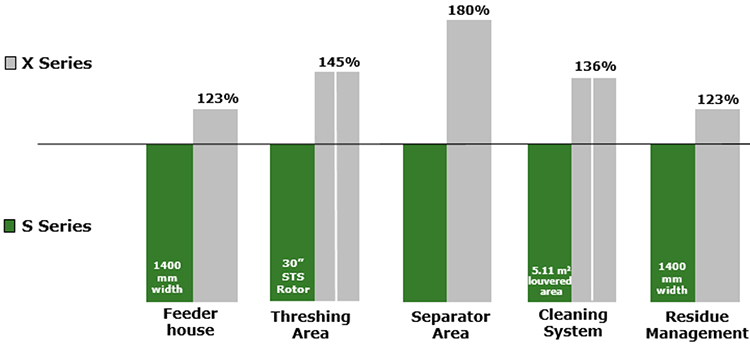 Comparison of features between S-Series and X Series Combines
Comparison of features between S-Series and X Series Combines
- More productivity in the early morning and late afternoon – The feederhouse is 23 percent wider than previous models, allowing it to handle as much as 100 tons/hr of wheat or 253,721.3 L (7200 bu) per hour of high-yielding corn. Increased rotor threshing and separation area improves your ability to harvest in tough conditions. Increased cleaning shoe area improves your grain tank sample, the 23 percent wider residue system can effortlessly chop and spread residue. The result is an X9 Combine that can handle early-morning’s thick wet crop or the highest-yielding parts of your field with less plugging.
- Automated setting adjustments with Combine Advisor™ package – Crop conditions change dramatically throughout the day and from field to field, which means you can spend time changing combine settings or you can run an X Series Combine that makes the adjustments for you. Combine Advisor adjusts all five harvesting settings as conditions change, reducing grain loss and improving quality. It automatically compensates for changing conditions like wet straw and dewy conditions, even if you can’t see them.
- Faster crop changeover with improved rotor/fast rpm shift, lighter concaves, and no-tools-required grain tank cleanout – Spend more time harvesting and less time prepping. The rotor and fast gear shift location has moved next to the cab door entrance for quick shifting when changing to different crops. The half-width concaves are lighter, making them easier to handle and remove. Each of the six concaves weigh less than 14 kg (31 lb), and drop-down cradles make it easy to slide the concaves into position. No tools are required to clean out the grain tank, making it easier to quickly remove crop before heading to the next field.
Make long harvesting days feel shorter with the most comfortable cab available
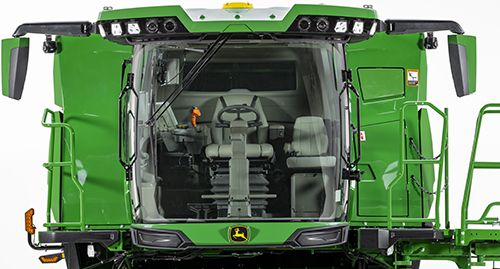 X Series cab
X Series cab
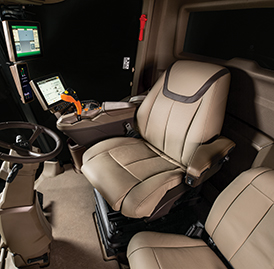 Leather seat inside of cab
Leather seat inside of cab
All X9 Combines provide a quiet, comfortable ride with visibility, control, and convenience that are even better than previous John Deere cabs. Choose from three comfort and convenience packages to find a cab that fits you best.
- Leather seat with massage, heating and cooling, electronic controls, and increased swivel (up to 16 degrees, both left and right) – When you sit down in the plush leather seat, the long days and nights won’t seem so long. It’s also quiet enough to take a phone call without worry. You’ll love the convenience of five cup-holders, an accessory rail with an iPad® tablet mount, USB and power ports, and closed storage. Plus, you can easily connect your smartphone to the 16.5-cm (6.5-in.) touchscreen radio to enjoy your favorite playlist or podcast.
- Smooth out 90 percent of vertical movements with ActiveSeat™ suspension – The electric motor responds instantly to the ruts, bumps, and jolts, delivering an unbelievably comfortable ride. While you’re harvesting more acres per hour, you’ll stay refreshed and alert.
- Get unmatched visibility – The 360-degree light-emitting diode (LED) lighting package delivers twice as much illumination as previous designs. Unloading on the go during the day is easier, too. The wide 106-degree unloading auger gives you a straight line of sight to the grain cart, while cameras on the unloading auger, grain tank, and rear of combine help you see into the grain cart, grain tank, and everything behind you.
- Make in-cab adjustments with more programmable features on the CommandARM™ controls – Feeder house tilt, header resume, machine speed, AutoTrac™ guidance, unloading, residue spread widths, and even more features are located on the CommandARM controls using logical, color-coded, and easy-to-read icons that make it a breeze to run the combine or train new operators. You can even program the functions you use most with up to 30 percent more programmable features than any other combine controller.
iPad is a trademark of Apple Inc.
Make quick, informed decisions in a combine packed with ready-to-harvest technology
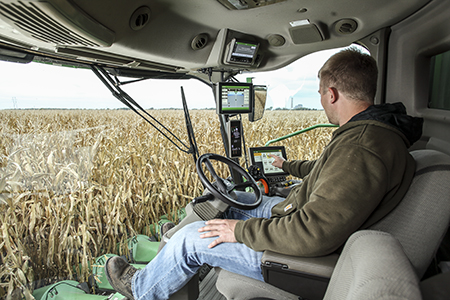 X Series in-cab technology
X Series in-cab technology
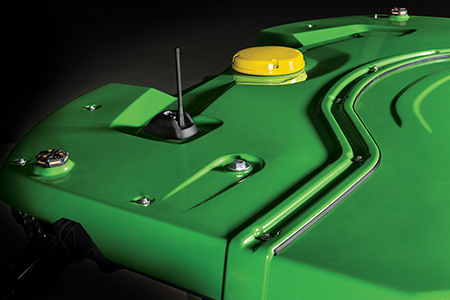 StarFire™ 7000 Integrated Receiver
StarFire™ 7000 Integrated Receiver
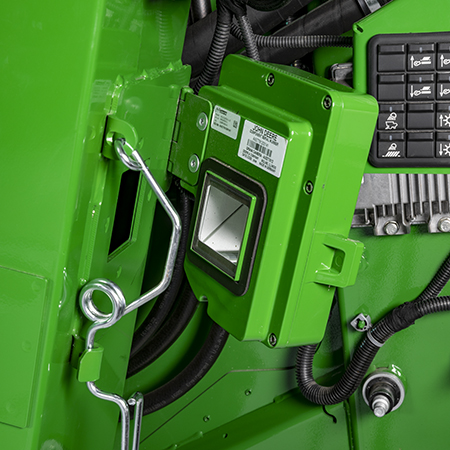 X Series Combine Advisor™ ActiveVision™ tailings camera
X Series Combine Advisor™ ActiveVision™ tailings camera
Make business decisions with the integrated technologies in the X Series. The combine learns on the go to improve your harvest, reduce losses, and leave cleaner grain. You’ll collect more accurate data, improve harvest results with automation, and make more informed decisions by connecting all your machines. What’s even better, the X9 Combines do much of this automatically in the background.
- StarFire™ Integrated Receiver eliminates all setup, installation, and calibrations – The integrated design is ready to harvest with AutoTrac™ guidance in base. There is no need to verify machine and receiver measurements, as this has been done precisely for you at the factory.
- Improve grain quality and reduce losses with Combine Advisor™ package - Automatically adjust the combine’s harvest settings. Cameras on the clean grain and tailings elevator help you make informed decisions on the crop that is flowing up and into the grain tank.
- G5 Advanced Combine License - The combine can unload 100 times or more every day with larger heads, so caution and safety are even more important. Machine Sync connects the grain cart to the combine, letting the combine operator adjust the speed and location of the cart, automating all tractor movement. In-Field Data Sharing enables the grain cart operator to see where all the combines are in the field, as well as which one is closest to full, prioritizing unloading and improving overall logistics. AutoPath™ system maps each planter row and maximizes harvest efficiency by creating your harvest AB lines, keeping the header full during each pass.
- Send data to your home office, dealer, or trusted partners - All X9 Combines come with JDLink™, which automatically sends yield maps and other harvest data to the Operations Center for later analysis. From your office or from your smartphone, JDLink plus John Deere Operations Center Mobile gives you a look at all your machines – where they are, how they’re performing, and what action you can take to improve your harvest.
- Generate, collect, and analyze all your harvest data easier than ever with John Deere Operations Center - Operations Center makes it easier than ever to view, analyze, and compare different map layers and print out reports to make next year’s harvest even more profitable. Plus, you have access to more than 100 connected software tools, and you can easily share your harvest data with your trusted partners to help you make better decisions.
Key Specs
| Engine type | John Deere PowerTech™ PWS 13.6 L 830 cu in. |
|---|---|
| Rated power | 410 kW 549 hp |
| Fuel capacity | 1249.2 L 330 gal. |
| Rotor length | 3.51 m 11.5 ft |
| Rotor diameter | 60.1 cm 24 in. |
| Concave area | 1.6 m2 17.22 sq ft |
| Separating area | 3.6 m2 38.75 sq ft |
| Total cleaning area (louvered) | 6.97 m2 75.02 sq ft |
| Grain tank size | 14,800 L 420 bu |
| Peak unloading rate | 162 L/s 4.6 bu/sec |
| Channel width | |
| Threshing cylinder diameter |
Engine
| Engine type | John Deere PowerTech PWS 13.6 L 830 cu in. |
|---|---|
| Emission level | Final Tier 4 (FT4) |
| Rated speed | 1900 rpm |
| Rated power | 410 kW 549 hp |
| Maximum power | 470 kW 630 hp |
| Power boost @ rated speed | 39.5 kW 53 hp |
| Fuel capacity | 1249.2 L 330 gal. |
| Engine family | PowerTech |
Feeding
| Drive type | Fixed or variable speed |
|---|---|
| Conveyor chain slat type | Four-strand chain with formed steel slats |
| Width | 1720 mm 67.7 in. |
| Length | |
| Feed Accelerator, Stone Trap (FAST) | Reverser Modulated feederhouse reverser Eight-wing chevron FAST |
Threshing/ Separating
| Separator type | Dual rotor |
|---|---|
| Rotor length | 3.51 m 11.5 ft |
| Rotor diameter | 60.1 cm 24 in. |
| Rotor speed range | 300 to 1300 rpm |
| Concave area | 1.6 m2 17.22 sq ft |
| Separating area | 3.6 m2 38.75 sq ft |
| Discharge grate area | 0.4508 m2 4.85 sq ft |
| Separator drum diameter | |
| Separator drum speed | |
| Threshing cylinder speed range |
Cleaning
| Front chaffer | 0.97 m2 10.4 sq ft |
|---|---|
| Front chaffer extension | |
| Pre cleaning | |
| Chaffer | 3.13 m2 33.69 sq ft |
| Sieve area | 2.87 m2 30.89 sq ft |
| Total cleaning area (louvered) | 6.97 m2 75.02 sq ft |
| Cleaning fan speed | 570 to 1430 rpm |
Grain handling
| Grain tank size | 14,800 L 420 bu |
|---|---|
| Unloading auger length | 7.9, 8.7, or 9.45 m 26, 28.5, or 31 ft |
| Peak unloading rate | 162 L/s 4.6 bu/sec |
Base weight - less head
| Total machine |
|---|
Manufacturing location
| Country | United States |
|---|
Additional information
| Date collected | 15 June 2020 |
|---|
Locations
- Angleton (979) 849-2325
- Conroe (936) 788-6677
- Corpus Christi (361) 452-0678
- Hockley (281) 256-6900
- Houston South (713) 943-7100
- Houston Southwest (713) 541-3535
- Jasper (409) 384-7523
- Jersey Village (713) 466-7456
- Katy (281) 391-2165
- League City (281) 338-1300
- Livingston (936) 788-5590
- Robstown (361) 387-2564
- Spring (281) 353-0204
- Hunstville (936) 788-6680
Site Map
Follow Us
Copyright © 2025 King Ranch Ag & Turf All Rights Reserved. Website by EquipmentLocator.com

